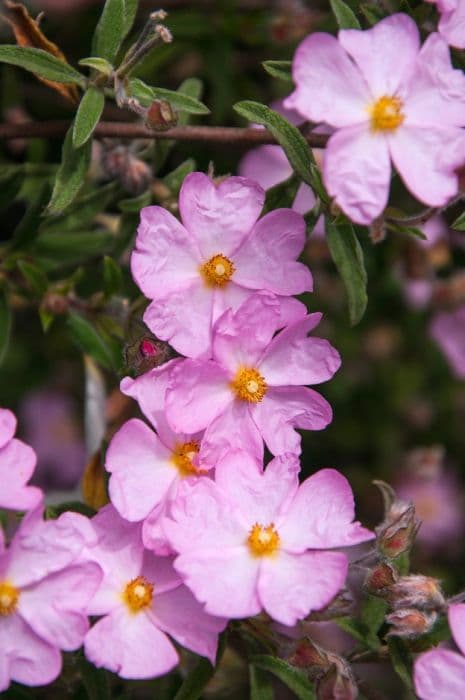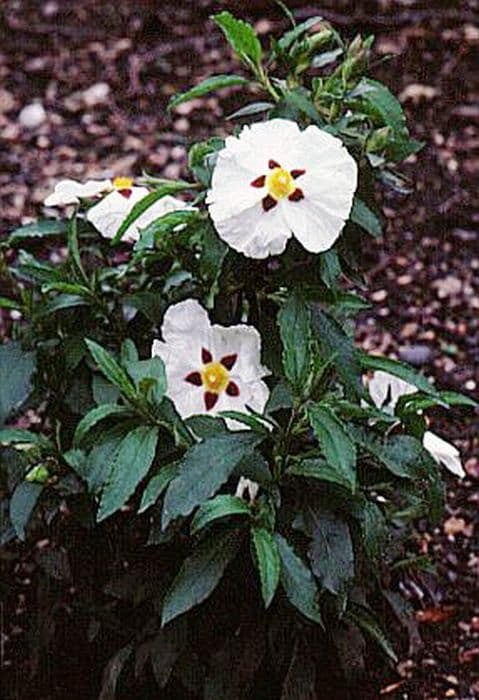Skanberg cistus Cistus × skanbergii

ABOUT
Cistus × skanbergii, commonly known as the pink rockrose, is a plant that holds a notable charm due to its delicate, papery blooms. These flowers, typically coming in a gentle pink hue, present themselves with a simple yet elegant form that usually includes five petals. The center of each bloom is graced with a cluster of conspicuous yellow stamens that add a complementary splash of color, creating an attractive visual contrast against the soft pink petals. The foliage of the pink rockrose consists of small, narrow leaves that possess a slightly sticky texture. These leaves are usually a grayish-green color, lending a muted yet sophisticated background to the brighter flowers. The leaves’ stickiness is due to the presence of tiny glandular hairs which can lend a faint aromatic quality to the plant. The overall habit of the pink rockrose is spreading with its branches often taking a slightly arching form. This gives the plant a relaxed, informal look that can fit in well with a naturalistic planting scheme or can provide a charming accent in a more structured garden setting. The pink rockrose is particularly appreciated for its showy floral display and can contribute a burst of color in the landscape when in bloom.
About this plant
 Names
NamesFamily
Cistaceae
Synonyms
Pink Rock Rose, Skanberg's Cistus
Common names
Cistus × skanbergii
 Toxicity
ToxicityTo humans
The Cistus × skanbergii, commonly known as Pink Rockrose, is not known to be toxic to humans. There are no well-documented symptoms of poisoning from ingesting parts of this plant. Therefore, consuming the Pink Rockrose typically does not lead to any adverse health consequences.
To pets
The Pink Rockrose is also not known to be toxic to pets. It is not associated with any specific symptoms of poisoning in animals such as dogs and cats, and ingestion of parts of this plant generally does not result in harmful effects for them.
 Characteristics
CharacteristicsLife cycle
Perennials
Foliage type
Evergreen
Color of leaves
Green
Flower color
Pink
Height
3 feet (0.91 meters)
Spread
5 feet (1.52 meters)
Plant type
Shrub
Hardiness zones
8
Native area
Mediterranean
Benefits
 General Benefits
General Benefits- Drought tolerance: Cistus × skanbergii is well-suited to dry climates and tolerant of periods without water once established.
- Low maintenance: This plant requires minimal care once established, making it a good choice for gardeners seeking low-effort landscapes.
- Attracts pollinators: The flowers provide a food source for bees and other beneficial insects, enriching the local ecosystem.
- Erosion control: Its root system helps to stabilize soil and prevent erosion on slopes or in areas prone to soil loss.
- Ornamental value: The plant has attractive, pale pink flowers and evergreen foliage that provide visual interest and aesthetic appeal in gardens.
- Tolerates poor soils: Cistus × skanbergii can thrive in a range of soil types, even those with less fertility or poor conditions.
- Resistant to pests and diseases: This plant has natural resistance to common pests and diseases, reducing the need for chemical treatments.
- Fire-resistant properties: The plant is considered to have a degree of fire resistance, which can be beneficial in fire-prone regions.
- Fast-growing: Quick growth makes it suitable for gardeners looking to establish plantings in a relatively short period.
- Habitat enhancement: It provides shelter and habitat to various small animals and insects, supporting biodiversity.
 Medical Properties
Medical PropertiesThis plant is not used for medical purposes.
 Air-purifying Qualities
Air-purifying QualitiesThis plant is not specifically known for air purifying qualities.
 Other Uses
Other Uses- Landscape Beautification: Cistus skanbergii, commonly known as Pink Rockrose, is often used in gardens and landscaping designs for its attractive pink flowers and evergreen foliage.
- Erosion Control: Pink Rockrose is useful for stabilizing soil and controlling erosion on slopes and banks due to its hardy and spreading nature.
- Wildlife Habitat: The dense shrub provides cover and nesting sites for birds and other wildlife.
- Drought-Tolerant Planting: Due to its drought resistance, Pink Rockrose is a popular choice for xeriscaping, which requires minimal irrigation.
- Ground Cover: Its low-growing and spreading habit makes it effective as a ground cover to suppress weeds.
- Bee Attraction: The flowers of Pink Rockrose are known to attract bees, hence contributing to pollinator support.
- Fire Resistant Planting: The plant is considered to have some fire-resistant properties making it useful in fire-prone regions for creating defensible space.
- Culinary Garnish: Though not commonly known for culinary use, the petals of Pink Rockrose can be used as a decorative garnish for salads and desserts.
- Herbal Teas: The leaves, although not commonly used, can sometimes be found in herbal tea blends for their aromatic quality.
- Perfume and Scented Products: The aromatic resin (known as labdanum) gathered from the leaves and twigs of the Pink Rockrose is used in perfumery and in making scented candles and potpourri.
Interesting Facts
 Feng Shui
Feng ShuiThe Rockrose is not used in Feng Shui practice.
 Zodiac Sign Compitability
Zodiac Sign CompitabilityThe Rockrose is not used in astrology practice.
 Plant Symbolism
Plant Symbolism- Healing: The Cistus genus, which is closely associated with rockrose, has been used in traditional medicine to heal various ailments, symbolizing the plants' potential restorative properties.
- Resilience: Cistus × skanbergii is renowned for its ability to thrive in poor soil conditions and resist drought, thus representing endurance and the ability to withstand challenging circumstances.
- Beauty: The plant's attractive flowers are a symbol of natural beauty and grace, often reminding us of the aesthetic pleasures that nature offers.
- Survivial: Given its propensity to recover after fires, rockrose can signify rebirth and the strength to bounce back from adversity.
- Purity: The white color of Cistus × skanbergii's flowers traditionally symbolizes purity and cleanliness.
 Water
WaterFor the Pink Rockrose, water sparingly, allowing the soil to dry out slightly between waterings. This means typically watering every 7 to 10 days during active growth in spring and summer, but less frequently during the fall and hardly any in winter. When watering, provide a thorough soaking, ensuring water reaches the root zone. Depending on the size of the plant, this may be equivalent to about 1-2 gallons for large shrubs every couple of weeks in the summer, but adjust the amount according to weather conditions and soil drainage.
 Light
LightThe Pink Rockrose thrives in full sun conditions, appreciating bright, direct light for most of the day. It is best planted in a spot where it will receive at least 6 hours of sunlight daily. Avoid placing it in areas with heavy shade or where buildings or other plants significantly block sunlight as this will affect its growth and flowering.
 Temperature
TemperatureThe Pink Rockrose is adapted to a Mediterranean climate and prefers a temperature range between 50°F and 85°F but can tolerate brief periods outside this range. This plant can withstand temperatures as low as 20°F but should be protected from prolonged freezing conditions. Ideally, maintain a warm, temperate environment for optimal growth.
 Pruning
PruningPruning the Pink Rockrose is done to shape the plant, remove any dead or damaged branches, and encourage a bushier growth habit. It's best to prune right after the plant finishes blooming in late spring or early summer. Light pruning can be done once a year; more extensive shaping should be done less frequently, as needed.
 Cleaning
CleaningNot needed
 Soil
SoilPink rock rose (Cistus × skanbergii) thrives in well-draining soil with a pH range of slightly acidic to neutral, around 6.0 to 7.5. A good mix for pink rock rose would include equal parts of gritty sand, loam, and peat or compost for organic content, which ensures proper drainage and aeration.
 Repotting
RepottingPink rock rose (Cistus × skanbergii) doesn't require frequent repotting and can typically be repotted every two to three years. It's best to repot in the spring just before new growth begins.
 Humidity & Misting
Humidity & MistingPink rock rose (Cistus × skanbergii) is tolerant of a range of humidity levels and does well in dry conditions. It does not require high humidity, making it well-suited to the average humidity found in most outdoor environments.
 Suitable locations
Suitable locationsIndoor
Bright, direct light; well-drained soil; minimal watering.
Outdoor
Full sun; well-drained soil; protect from severe frosts.
Hardiness zone
8-11 USDA.
 Life cycle
Life cycleCistus × skanbergii, commonly known as the Skanberg rockrose, begins its life as a seed that germinates in the warm, moist conditions of late winter or spring. Following germination, it enters the seedling stage where it develops a basic root system and its first true leaves. As the plant matures into the vegetative stage, it develops a woody stem and a more extensive root system, along with characteristic gray-green foliage. The Skanberg rockrose then reaches the flowering stage, typically in late spring to early summer, producing pink flowers that attract pollinators. After pollination, it sets seeds, which are then dispersed by wind or wildlife, completing the reproductive stage. The plant will enter a period of dormancy during colder months, yet as an evergreen shrub, it retains its leaves throughout the year, with individual plants having an average lifespan of 5 to 10 years under ideal conditions.
 Propogation
PropogationPropogation time
Spring to early summer
Cistus × skanbergii, commonly known as Pink Rockrose, is typically propagated through semi-hardwood cuttings. This method involves taking cuttings from the semi-ripe new growth of the plant during the late summer months, ideally from mid-July to August. The cuttings, about 4 to 6 inches (10 to 15 cm) long, should be snipped just below a leaf node, and the lower leaves should be removed. The cut end of the cutting is then dipped in a rooting hormone to encourage root development and planted in a well-draining potting mix. The pot should be placed in a warm, sheltered location with indirect sunlight, and kept moist until the cuttings have rooted, which usually takes a few weeks. Once rooted, the new Pink Rockrose plants can be gradually acclimatized to outdoor conditions before planting in their permanent positions in the garden.









